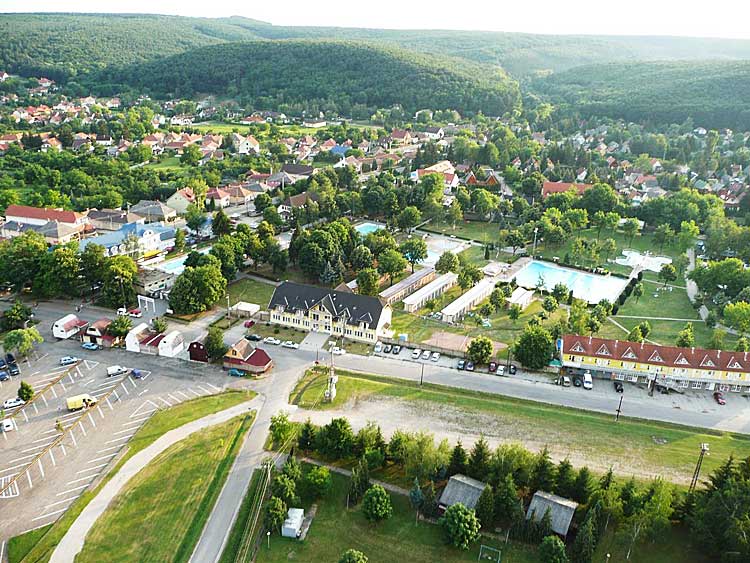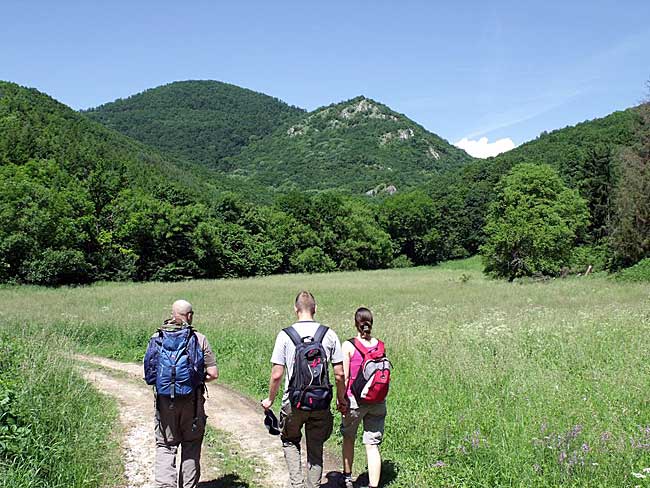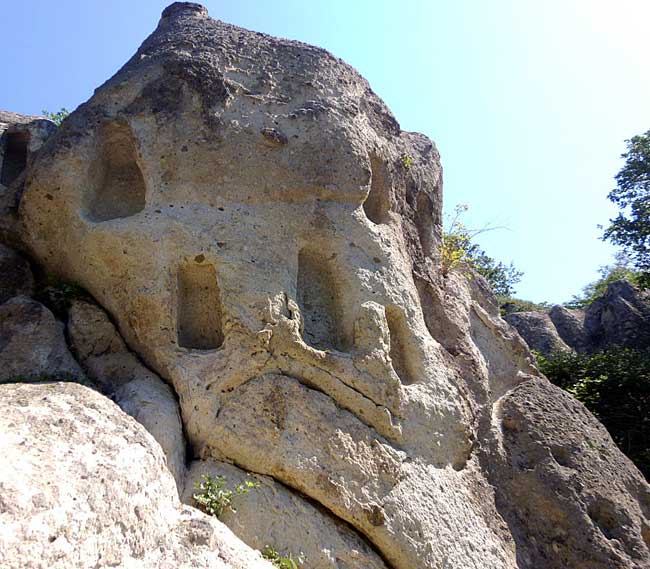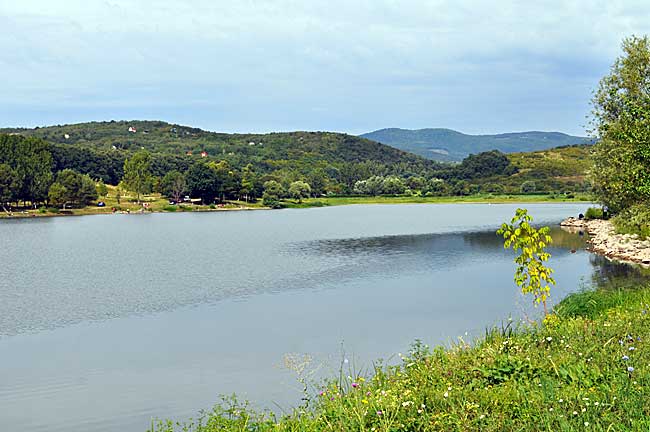 Thermal bath at the foot of the Bükk MountainsAt the foot of the Bükk Mountains visitors are not only attracted by the forests and little streams running down from the mountain but also what nature and man himself carved into the stones: caves, beehive stones, cave dwellings and wine cellars. Several hiking trails help hikers, and more experienced trekkers can ride a mountain bike along the spectacular valley of the Hór Stream. But even if you decide to stay in Bogács, you can also get to know nature: the mountain near the wine cellars, the water at the fishing lake, the surrounding scenery looking down from the gazebo.
Thermal bath at the foot of the Bükk MountainsAt the foot of the Bükk Mountains visitors are not only attracted by the forests and little streams running down from the mountain but also what nature and man himself carved into the stones: caves, beehive stones, cave dwellings and wine cellars. Several hiking trails help hikers, and more experienced trekkers can ride a mountain bike along the spectacular valley of the Hór Stream. But even if you decide to stay in Bogács, you can also get to know nature: the mountain near the wine cellars, the water at the fishing lake, the surrounding scenery looking down from the gazebo.
Travellers are accompanied here by the 300-400-meter high mountains of the Bükk but this region is already a transition from the Bükk Mountains to the Great Plains. The scenery has been formed by the streams running down the mountains. In their valleys, which are situated like the teeth of a comb, villages can be found. On the other side of Road No. 3 (and the motorway) hikers can see the unique flora and fauna of the South-Borsod Plains. However, Bogács has always had the atmosphere of the mountains and their attractions are closer, too. You can go for a very pleasant walk, trip or hiking tour on the trails even by bike if you want.
 Hikers in the valley of the Hór StreamBogács is situated in the valley of the Hór Stream – and this is one of the longest valleys in the country. Walking in it on gravel or dirt roads you can get as far as Bükkszentkereszt following the hiking trail. During the way not only nature but man-made things offer something to admire. At the beginning of the trail in the high mountain towering over the forest path is the Suba Hole Cave, where the remains of the Hungarian Neanderthal man were found. The land is rich in cave dwellings carved into the loose volcanic tuff.
Hikers in the valley of the Hór StreamBogács is situated in the valley of the Hór Stream – and this is one of the longest valleys in the country. Walking in it on gravel or dirt roads you can get as far as Bükkszentkereszt following the hiking trail. During the way not only nature but man-made things offer something to admire. At the beginning of the trail in the high mountain towering over the forest path is the Suba Hole Cave, where the remains of the Hungarian Neanderthal man were found. The land is rich in cave dwellings carved into the loose volcanic tuff.
The Bükkalja Hills can also be called "the land of beehive stones" since more than two-thirds of the Hungarian beehive stones can be found here: about 470 rock sockets have been carved in the 72 rhyolite tuff towers. Near Bogács in Hintóvölgy a five-socket beehive stone can be seen.
 The sights of this region are the beehive stonesThese mysterious shapes have been formed by nature and man together. Gullies and other surface shaping processes formed towers and cones from the rhyolite tuff hills. In these shapes man carved 60 cm high, 30 cm wide and 25-30 cm deep sockets, the purpose of which is still unknown to us.
The sights of this region are the beehive stonesThese mysterious shapes have been formed by nature and man together. Gullies and other surface shaping processes formed towers and cones from the rhyolite tuff hills. In these shapes man carved 60 cm high, 30 cm wide and 25-30 cm deep sockets, the purpose of which is still unknown to us.
Their present name suggests that these sockets were somehow in relation with apiary in the 11th-14th centuries. But they had other names, as well: churn stone, window stone, false window stone, idol stone. Therefore it is not impossible that there may be another explanation for them, but according to this they were used for storing urns or sacrificial presents.
Not far from the border of the village you can find Hintóvölgy to the east and Jács Valley to the west. The latter's special microclimate made it possible for several old trees to be still alive, the oldest being 250-300 years old. On the ridge of the mountain next to the valley Tomori Castle used to stand, whose ruins have basically disappeared by now. The attractions of Hintóvölgy are the wine cellars carved into the rhyolite tuff and the above mentioned beehive stone.
 Anglers’ favourite destination is the fishing lake made by the swelling of the Szoros StreamBükkalja preserves the old traditions of grape and fruit culture, whose evidence are the typical wine cellars, sometimes not only one row of them but several. In Bogács the cellars were built right next to each other, and these stone-facaded, triangle-roofed, tiny wine houses show from afar what is hiding inside of the mountain. However, at the oldest cellars there are no tiny wine houses: the doors of the cellars were carved into the smooth wall of the mountain itself and now they are marked by small iron doors. The most famous is the wine cellars in Cserépi Road, but the ones in Csecs-lyuk and Hintóvölgy are also worth mentioning.
Anglers’ favourite destination is the fishing lake made by the swelling of the Szoros StreamBükkalja preserves the old traditions of grape and fruit culture, whose evidence are the typical wine cellars, sometimes not only one row of them but several. In Bogács the cellars were built right next to each other, and these stone-facaded, triangle-roofed, tiny wine houses show from afar what is hiding inside of the mountain. However, at the oldest cellars there are no tiny wine houses: the doors of the cellars were carved into the smooth wall of the mountain itself and now they are marked by small iron doors. The most famous is the wine cellars in Cserépi Road, but the ones in Csecs-lyuk and Hintóvölgy are also worth mentioning.
After the swelling of the Szoros Stream a 26 hectare (64 acres) artificial lake was formed 300 metres from the bath, which is now a popular fishing paradise. The following fish can be found in the lake: carp, meagre, tench, bass and pike. This is the hibernacle of wild ducks, and also a resting place of a few of our migratory birds during migrating: swans and wild geese.
Looking down from the gazebo we can see Bogács, the neighbouring settlements, and we can admire the beautiful landscape around and below us. To the north we can see the southern part of the several-century-old, tree-covered slopes of the Bükk Mountains. If we look to the south, we can see as far as the South-Borsod Plains and the Heves Plains.





